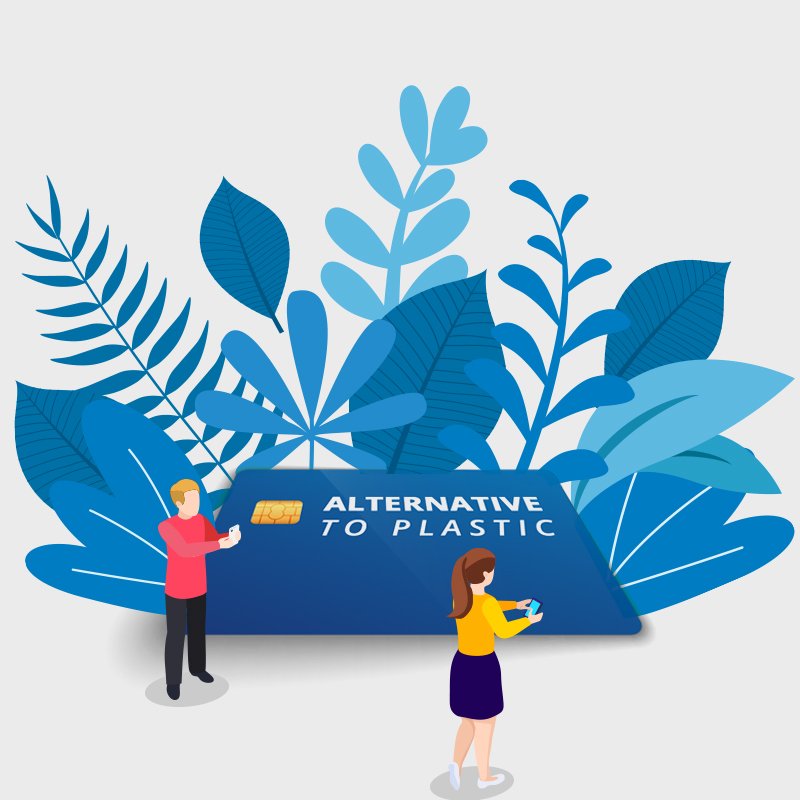reinventing personalization: alternative to plastic payment cards

It comes as no surprise that we urge consumers to opt for digital & contactless payments as a way to cope with banking 4.0. With the global payments industry and banks reaching a common consensus over the winning business formula, its dynamics over choosing a consumer-favorite payment method still vary dramatically by region. This regards for a disaggregated assessment on payment solutions.
All around the globe, payment card transaction’s average compounded annual growth rate has increased from 5% to 9%, and in the MENA, contactless payments had increased by 200% in Q1 of 2020, leaving the spotlight on payment cards. 6 billion payment cards are produced on average each year, and though it’s only 0.15 % of world plastic usage, it equates to 1.85 times the number of stars in our galaxy. We aim to caution banks on the excessive use of PVC plastic and glance at the underlying environmental impact caused by industry-standard PVC, to convey the use of alternatives-to-plastic payment cards.
Preparing for the next wave of consumer personalization
Incumbent banks realize the need for greater personalization and the need to build new consumer-product relationships. The introduction of personalization into their payment offerings, especially their payment cards portfolio, should be provided with dynamically different product design and delivery, while keeping the environment intact of further damage.
Trends Shaping Physical & Digital Payments
Fintech ventures in the MENA region have been gaining popularity which is great news for plastics. Fintech is a great alternative to traditional banking as it allows consumers to manage their banking needs digitally, even reducing the reliance on paper. The new model allows banks to offer customer-centricity at its core product proposition whether in payments, account opening, personal financing, loans and added-value services. The current consumer banking business model however, lacks the personalization needed to compete across all customer segments. Inserts and PIN mailers and all the paper-work associated with delivering and activating cards are omitted and can all be provided to consumers with a sustainable alternative via the mobile app. The shifting trends toward digital banking and mobile payment can potentially help manage the card life-cycle and reduce the use of plastics for cards and plastic waste.
Product-led differentiation
Banks can also produce innovative and eco-friendly payment cards, such as wood cards and metal cards, each with its own set of payment instruments and smart added-value services to offer personalization at every consumer-product touchpoint. The search here goes towards coming up with a product that has an eco-friendly cause, such as fighting plastic-pollution, with an alternative-to-plastic payment card; We are able to produce & deliver, with our Partner Kona, MasterCard & Visa approved Ecozen payment cards, Wood payment cards or Metal payment cards made from bio-sourced material, running on a business model with greater prudence towards environmental stability. Alternatively, banks can choose to use plastic substitutes such as polylactic acid (PLA) which is biodegradable and recyclable. It is made from renewable sources such as plant leaves and corn, and it is compatible with magstripe, contact and dual interface technologies.
Multi-Channel Distribution
Way4 Card Management system responds to the need for targeted deployment and distribution with agile and flexible technology, laying ground for an omni-channel digital banking platform that can deploy and distribute products/services with minimal operating costs and with the scalability of Platform as a Service. Card issuers can run multiple business models for debit cards, credit cards, and pre-paid payment cards on the same platform; a virtual payment card can be issued, that is 3-D secure and powered by tokenization, to be distributed across your bank’s digital channels. This solution is innovative and provides a sustainable alternative-to-plastics payment solution while keeping the option to deploy payment cards with sustainable material such as PLA, or the aforementioned wood and metal cards.